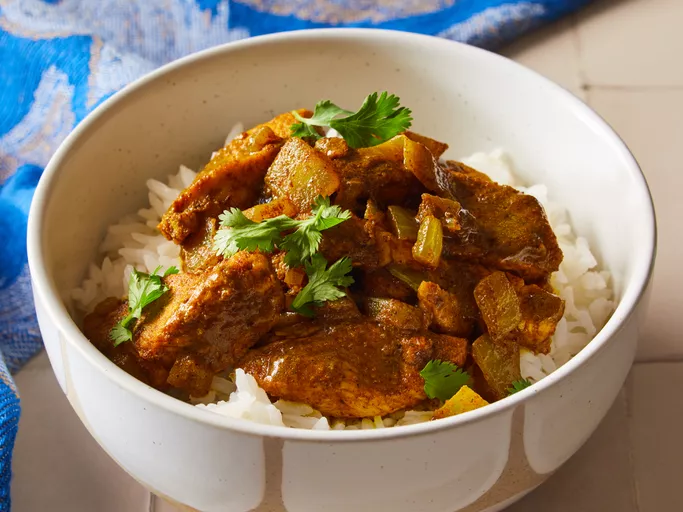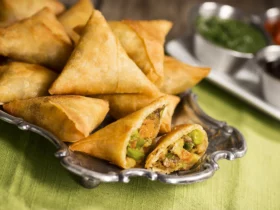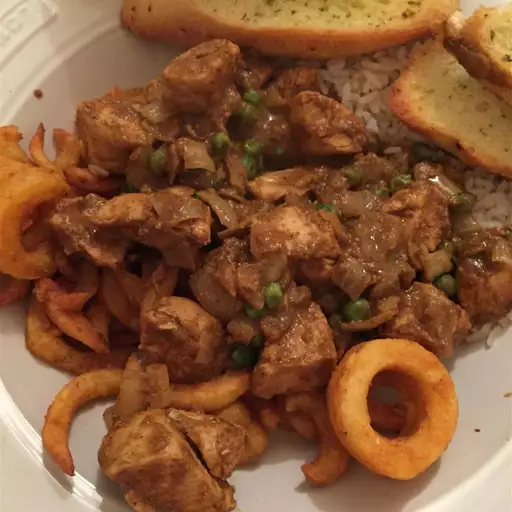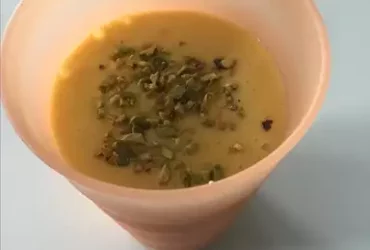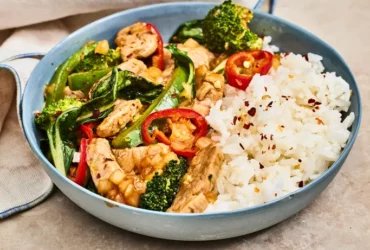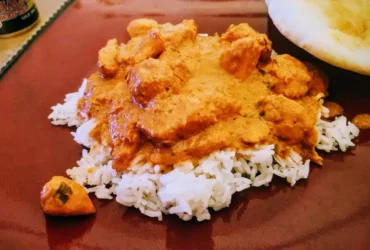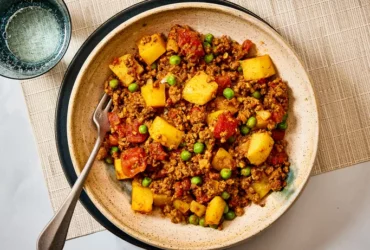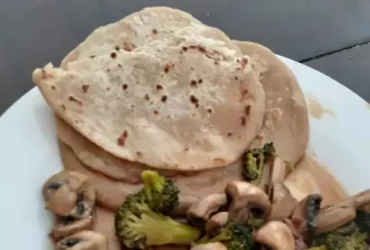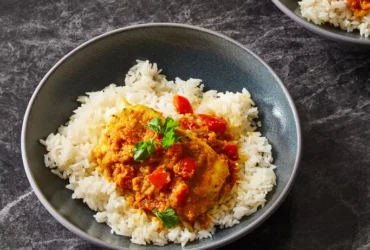Ingredients
You’ll need
The following ingredients are required for this easy chicken curry recipe:
Main Ingredients:
- 1 1/2 pounds boneless, skinless chicken breast or thighs, cut into bite-sized pieces
- 2 medium onions, diced
- 3 cloves of garlic, minced
- 1 tablespoon grated fresh ginger
- 1 teaspoon ground cumin
- 1 teaspoon curry powder
- 1/2 teaspoon turmeric powder
- 1/2 teaspoon cayenne pepper (optional)
- Salt, to taste
- Fresh cilantro leaves, for garnish
Oil and Spices:
- 2 tablespoons vegetable oil or coconut oil
- 1 teaspoon ground cinnamon
- 1/2 teaspoon ground cardamom
- 1/4 teaspoon ground cayenne pepper (optional)
- 1/4 teaspoon black pepper, freshly ground
Tomatoes and Coconut Milk:
- 1 can (14 oz) diced tomatoes
- 1 cup coconut milk
- 2 tablespoons tomato paste
Liquid and Flavorings:
- 2 cups water or chicken broth
- 2 tablespoons lemon juice
- 1 teaspoon ghee or vegetable oil (optional)
Curry paste or curry powder
Curry paste and curry powder are two essential ingredients used to give the classic Indian dish of chicken curry its distinctive flavor and aroma. While they serve a similar purpose, they have distinct differences in terms of texture, taste, and usage.
Curry paste is a thick and creamy mixture made from a combination of spices, herbs, and sometimes yogurt or coconut milk. It’s often sold in jars or tubs and can be found in most supermarkets that carry international ingredients. Curry paste typically contains a blend of spices such as turmeric, cumin, coriander, cinnamon, cardamom, and red pepper flakes.
Curry powder, on the other hand, is a dry powder made from ground spices. It’s commonly sold in small bottles or containers and can be found in most supermarkets that carry international ingredients. Curry powder typically contains a blend of spices such as turmeric, cumin, coriander, cinnamon, cardamom, and red pepper flakes.
The main difference between curry paste and curry powder is the texture. Curry paste is thick and creamy, while curry powder is dry and powdery. This makes curry paste easier to mix into sauces or marinades, while curry powder needs to be mixed with a liquid ingredient before using it in a recipe.
Another key difference between curry paste and curry powder is the flavor. Curry paste has a more intense and complex flavor profile due to the presence of spices such as cardamom, cinnamon, and nutmeg. Curry powder, on the other hand, has a milder flavor that’s often used in dishes where a subtle Indian-inspired taste is desired.
In terms of usage, curry paste is often used as a base for sauces or marinades, while curry powder is often used as an ingredient in its own right. In the context of an easy chicken curry recipe, using curry paste will result in a more flavorful and intense dish, while using curry powder will produce a lighter and milder flavor.
When choosing between curry paste and curry powder for your recipe, consider the type of dish you’re making. If you want a rich and intense Indian-inspired flavor, use curry paste. If you prefer a lighter and more subtle flavor, use curry powder.
In conclusion, while both curry paste and curry powder are essential ingredients in many Indian recipes, they have distinct differences in terms of texture, taste, and usage. By choosing the right one for your recipe, you can create delicious and authentic-tasting dishes that will impress even the most discerning palates.
Onion, ginger, garlic
The art of crafting an exceptional Easy Chicken Curry Recipe lies not only in the technique, but also in selecting the finest ingredients that bring depth and complexity to the dish.
Here’s a closer look at three fundamental components that form the base of our recipe: Onion, Ginger, and Garlic – each playing a vital role in elevating the flavor profile of your curry.
Onion
- The onion is perhaps one of the most universally used ingredients in cooking. It adds a depth of flavor to many dishes, including our Easy Chicken Curry Recipe.
- When selecting an onion for your curry, it’s essential to choose one that has not been stored for too long as it can lead to a slightly bitter taste.
Ginger
- Ginger is another key component of our recipe. It adds a spicy and slightly sweet flavor, which perfectly complements the onions in your curry.
- Choose fresh ginger for the best results; frozen or dried ginger can lack the potency and freshness of its counterpart.
Garlic
- Like onion, garlic is an essential ingredient in many cuisines around the world. In our Easy Chicken Curry Recipe, it adds a rich and savory flavor that balances out other spices.
- When selecting garlic for your curry, choose bulbs that are firm to the touch with no signs of sprouting or mold. The fresher your garlic is, the better the flavor in your dish will be.
In conclusion, onion, ginger, and garlic form a strong trio at the heart of our Easy Chicken Curry Recipe. Each ingredient plays a critical role in delivering an exceptionally delicious dish that combines both Eastern and Western flavors for the perfect fusion taste experience.
Turmeric, cumin, coriander, salt, black pepper
The star ingredients of this easy chicken curry recipe are a blend of aromatic spices that add depth and warmth to the dish. The first key ingredient is Turmeric, a bright yellow spice that’s commonly used in Indian cuisine. It has a slightly bitter, earthy flavor and a vibrant orange-yellow color.
Next up is Cumin, a warm, earthy spice that adds a rich, slightly sweet flavor to the curry. Cumin seeds or ground cumin can be used, depending on personal preference.
Another essential spice in this recipe is Coriander, which has a fresh, citrusy flavor and aroma. Ground coriander can be used, but whole coriander seeds also add a nice texture and flavor to the dish.
Salt is used to bring out the flavors of all the other spices in this recipe. Use a high-quality salt, like Himalayan pink salt or sea salt, for the best results.
Finally, we have Black Pepper, which adds a nice kick and aroma to the curry. Freshly ground black pepper is always best, as it has a more vibrant flavor than pre-ground pepper.
In addition to these spices, you’ll need some chicken breast or thighs for the protein component of this recipe. Boneless chicken works well in this dish, but bone-in chicken can also be used for added flavor and texture.
Cooked chicken breast or thighs
Cooked chicken breast or thighs are essential ingredients in many recipes, including the popular and easy-to-make chicken curry. When using cooked chicken in a curry recipe, it’s best to use boneless, skinless chicken breasts or thighs that have been cooked until they reach an internal temperature of at least 165°F (74°C).
This ensures food safety and helps to prevent foodborne illnesses. You can cook the chicken by grilling, baking, or sautéing it in a pan with some oil until it’s fully cooked. Once the chicken is cooked, let it cool down before cutting it into small pieces or shreds.
For this easy chicken curry recipe, you’ll want to use about 1-2 pounds of cooked chicken breast or thighs, depending on your personal preference for the amount of protein in the dish. You can also customize the amount of chicken based on the number of people you’re serving and their individual appetites.
When selecting chicken breasts or thighs for this recipe, choose lean cuts that are free from visible signs of fat and other contaminants. It’s also a good idea to look for chicken that has been labeled as “no added hormones” or “no antibiotics,” as these options tend to be healthier and more sustainable.
Before adding the cooked chicken to your curry sauce, make sure it’s at room temperature, so it doesn’t lower the temperature of the sauce when you add it. This helps ensure that the sauce cooks evenly and prevents the risk of foodborne illness from consuming undercooked or raw meat.
Instructions
Sauté the aromatics
To start making this delicious and easy chicken curry recipe, let’s focus on sautéing the aromatics, which are the foundation of a great curry.
The first step in sautéing the aromatics is to heat a couple of tablespoons of oil in a large pan over medium heat. You can use any type of oil you prefer, such as vegetable or canola oil, but for this recipe, we recommend using a neutral-tasting oil like coconut oil.
Once the oil is hot, add the aromatics to the pan. For this curry, the aromatics are going to include onions, ginger, and garlic. Chop the onion into medium-sized pieces and mince the ginger and garlic.
As the onions start to soften and caramelize, use a spatula to gently stir them. This will help prevent burning and ensure that they cook evenly.
Once the onions have turned translucent, add the minced ginger and garlic to the pan. Continue stirring constantly as you sauté for another minute or until the ginger and garlic are fragrant and lightly browned.
This step is crucial in bringing out the natural flavors of the aromatics, which will then complement the rest of the ingredients in the curry. Be careful not to burn them, as this can create an unpleasant flavor that’s hard to mask with spices.
As you sauté the aromatics, take note of their texture and color. They should be soft and slightly caramelized, which will add depth to your final curry dish.
Once the aromatics are cooked through, it’s time to add the next set of ingredients that will bring this chicken curry recipe together. Next up: adding the spices!
Melt 1 tablespoon of oil in a pan over medium heat.
To begin making this delicious Easy Chicken Curry Recipe, it’s essential to start with the preparation of a flavorful base. Begin by melting 1 tablespoon of oil in a pan over medium heat.
This initial step serves as a crucial foundation for developing the rich, complex flavors that come together in this signature Curry. The type of oil you choose to use will also impact the final taste. Commonly used oils in Indian cuisine include coconut oil, vegetable oil, or even ghee (clarified butter).
Once your chosen oil has melted and is evenly distributed across the bottom of the pan, it’s time to add the aromatics that will form the base of our Curry. Typically, these include onions, garlic, ginger, and sometimes other spices or herbs. The order in which you add these ingredients can make a significant difference in the final result.
Begin by adding a medium-sized onion, peeled and chopped into small pieces. You want to ensure that your onions are evenly cooked so they develop a deep golden brown color, adding a sweetness and depth of flavor to our Curry. Add a pinch of salt at this stage, not only to draw out the moisture from the onions but also to bring out their natural flavors.
After about 5-7 minutes, when your onion has started to soften and turn translucent, add in 2 cloves of minced garlic. Be sure not to burn your garlic as it can quickly become overcooked, resulting in an unpleasantly bitter taste. The Curry is all about balancing flavors, so it’s crucial to get the cooking time just right.
Once your onions and garlic have reached a softened consistency, add 1 inch of grated fresh ginger into the pan. Fresh ginger will not only provide its characteristic warm, spicy flavor but also an aromatic property that enhances the overall taste of the Curry.
Following this step, you can start building up your curry base with other essential spices such as cumin powder, coriander powder, turmeric, and red chili powder. Blend these spices well to form a uniform paste, then gradually add in some water or coconut milk to create the foundation of your Curry.
Continue cooking the mixture over medium heat until it has thickened into a smooth sauce, adding additional liquid as needed. Finally, this is where you can adjust the seasoning according to taste by adding more spices or herbs.
Now that we’ve developed our base curry paste, we’re ready to incorporate the chicken. Cut boneless, skinless chicken breast or thighs into bite-sized pieces and season them with a pinch of salt, black pepper, and a sprinkle of lemon juice to bring out their natural flavors.
Add the chicken to the pan and stir to coat evenly with our prepared curry paste. Cover the pan with a lid and allow it to simmer over low heat until the chicken is cooked through and coated in the rich Curry sauce.
This signature Easy Chicken Curry Recipe combines simple, readily available ingredients with the ancient secrets of Indian cooking. Enjoy its comforting flavors, served hot over steaming basmati rice or accompanied by your favorite flatbread.
Add sliced onion and sauté until softened.
Sautéing sliced onion is an essential step in many recipes, including our Easy Chicken Curry Recipe. This technique involves cooking the onion slowly over low-medium heat until it reaches a softened and translucent state.
The key to successful sautéing is to use the right amount of oil and heat. For this recipe, we recommend using about 1-2 tablespoons of neutral-tasting oil, such as canola or vegetable oil. Heat the oil in a large pan over medium heat, then add the sliced onion.
Allow the onion to cook for about 5-7 minutes, stirring occasionally. You may need to adjust the heat to prevent the onion from burning. Stir-frying is not necessary here; instead, let the onion simmer until it reaches a softened state.
The cooking process will break down the cellular structure of the onion, making it tender and caramelized in flavor. As the onion softens, it will release its natural sweetness, which will complement the flavors of our Easy Chicken Curry Recipe.
Add minced ginger and garlic, sauté for another minute.
Instructions for creating a delicious Easy Chicken Curry Recipe involve several steps that require attention to detail and patience, but one key component is adding aromatics such as minced ginger and garlic.
The addition of minced ginger and garlic is essential in many Indian-inspired dishes, including curries, due to their pungent flavor profiles and numerous health benefits. Ginger has anti-inflammatory properties and can aid in digestion, while garlic contains compounds that may help lower cholesterol levels and reduce blood pressure.
To incorporate the minced ginger and garlic into your Easy Chicken Curry Recipe, you will first need to prepare them for sautéing. Typically, this involves mincing the ingredients finely using a knife or a food processor, depending on their texture and desired consistency. The minced ginger and garlic are usually added together in the pan containing oil or another fat source.
The addition of minced ginger and garlic is not merely a matter of tossing them into the pan; it requires some finesse to avoid burning these delicate ingredients. When adding the minced ginger and garlic, reduce heat to medium-low to prevent them from scorching before they’ve had a chance to soften and release their flavors. This step should take only a minute or two.
After sautéing the minced ginger and garlic for another minute, they will have begun to mellow out in flavor and aroma, which is perfect for adding depth to your curry without overpowering it with bold spices. Now you can add other ingredients according to your Easy Chicken Curry Recipe, such as onions, tomatoes, spices, herbs, and protein sources.
The balance of flavors achieved through the slow sautéing of minced ginger and garlic is crucial in many curries. When combined correctly, these aromatics will form a flavorful foundation that can be built upon with other ingredients to create a dish that’s both aromatic and satisfying.
Cook the curry sauce
Create the sauce
To create the curry sauce for your easy chicken curry recipe, you will need a few key ingredients and some basic kitchen equipment.
First, let’s start with the ingredients:
- 2 medium onions, diced
- 3 cloves of garlic, minced
- 1 tablespoon grated fresh ginger
- 1 teaspoon ground cumin
- 1 teaspoon curry powder
- 1/2 teaspoon turmeric
- 1/2 teaspoon cayenne pepper (optional)
- 1 can (14 oz) diced tomatoes
- 1 cup chicken or vegetable broth
- Salt and pepper, to taste
- Fresh cilantro, for garnish
- Now, let’s talk about the equipment you will need:
- A large saucepan with a heavy bottom (stainless steel or enameled cast iron work well)
- A medium-sized bowl for whisking the sauce
- A wooden spoon or silicone spatula for stirring and scraping the pan
Now, let’s move on to the instructions:
Step 1: Sauté the Onions and Garlic
- In a large saucepan, heat 2 tablespoons of oil over medium-high heat. Add the diced onions and cook until they are translucent and starting to caramelize (about 5-7 minutes).
- Add the minced garlic and cook for another minute, stirring constantly to prevent burning.
Step 2: Add the Ginger, Cumin, Curry Powder, Turmeric, and Cayenne Pepper
- Add the grated ginger, ground cumin, curry powder, turmeric, and cayenne pepper (if using) to the saucepan. Cook for another minute, stirring constantly, until the spices are fragrant.
Step 3: Add the Diced Tomatoes and Broth
- Add the can of diced tomatoes and the cup of broth to the saucepan. Stir well to combine.
- Bring the mixture to a boil, then reduce the heat to medium-low and simmer for 15-20 minutes, or until the sauce has thickened slightly and reduced by about half.
Step 4: Season with Salt and Pepper
- Taste the curry sauce and adjust the seasoning as needed. Add salt and pepper to taste.
Step 5: Serve
- Serve the curry sauce over cooked chicken or rice, garnished with fresh cilantro if desired.
Add curry paste or curry powder to the pan, stir for 12 minutes.
- To cook the curry sauce, start by heating a couple of tablespoons of oil in a large pan over medium heat.
- Add 2-3 tablespoons of curry paste or curry powder to the pan, depending on your desired level of spiciness and flavor intensity.
- Stir the curry paste or curry powder into the oil using a spoon, ensuring it is fully incorporated and there are no lumps.
- Cook the mixture for 12 minutes, stirring constantly and scraping the bottom of the pan to prevent burning.
- This step is crucial in developing the flavor and aroma of the curry sauce. The long cooking time allows the spices to meld together and release their oils, creating a rich and complex flavor profile.
Pour in coconut milk or yogurt, bring the mixture to a simmer.
- To cook the curry sauce, heat a medium saucepan over medium-low heat and add the curry paste. Cook for about 1-2 minutes, stirring constantly, until the paste starts to release its oils and becomes fragrant.
- Add the coconut milk or yogurt to the saucepan, making sure it covers the bottom of the pan. This will help prevent the mixture from burning and sticking to the pan.
- Next, add the rest of the curry sauce ingredients to the saucepan: chicken broth, brown sugar, salt, and any other desired spices. Stir well to combine.
- Bring the mixture to a simmer by placing the saucepan over low-medium heat. You’ll know it’s simmering when you see small bubbles rising to the surface of the liquid.
- Allow the curry sauce to cook for 10-15 minutes, or until it has thickened slightly and reduced in volume. Stir occasionally to prevent burning.
- During this time, you can also add any additional ingredients such as diced chicken, potatoes, or vegetables to the curry sauce and simmer them until they are cooked through.
- Once the curry sauce has reached your desired consistency and flavor, remove it from heat and serve over basmati rice or with some naan bread.
- Best Datanyze Alternatives for 2025 - April 24, 2025
- Best Hunter.io Alternatives for 2025 - April 22, 2025
- Best Lead411 Alternatives for 2025 - April 22, 2025

